The Global Supply Chain of Bananas - from farms to your table
November 6, 2020
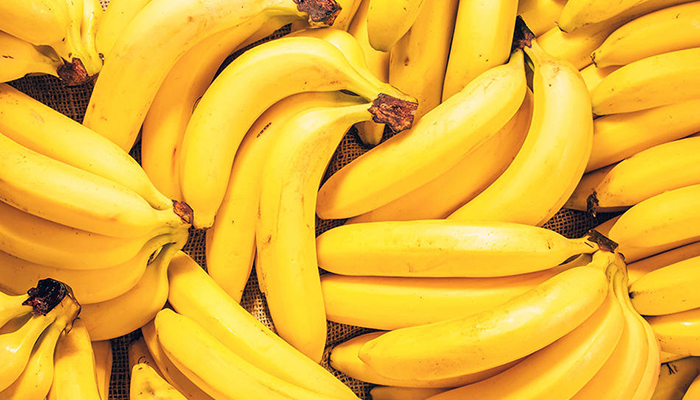
Bananas are one of the most popular fruits in the world. In Japan, we can find them at supermarkets, convenience stores and groceries. It is said that 9 to 15 bananas are consumed by one household every month in Japan. However, the production of bananas in Japan is quite low, and we import bananas from overseas to make up for the gap in domestic production, which is far below domestic consumption. This article introduces which country produces bananas and what kind of supply chain process bananas have to go through before coming to your table. This article also compares the difference in banana supply chain management among the world's three largest consumption areas, namely North America, Europe, and East Asia.
A wide variety of banana brands are placed on the banana shelves in supermarkets in Japan, but about 80% of them are imported from the Philippines. By the time bananas reach consumers, they go through the hands of producer, exporter, importer, ripening / distributor, and retailer. The long journey of the banana supply chain begins with the cultivation and planting of bananas in the exporting country. About 70 to 100 days later, the flowers of the banana trees bloom, the square fruits become rounded, and when the color of the fruits turns light green, it is time to harvest. Unlike other fruits, bananas can be harvested all year round, because banana production areas are distributed in tropical and subtropical areas. After the bananas are harvested, they are shipped to a local packing plant, washed thoroughly with water, and then sorted, weighed, and packed. When bananas are packed in a cardboard box, a number is stamped on the outside of the box. This number is the identity code, which identifies the farm where the banana was harvested, the packing facility, and the date and time of packing, that ensures the traceability of the bananas. Then, after packing is completed, after undergoing export inspection such as phytosanitary inspection, the bananas finally will be on board the vessel and cross over to the other side of the world.
It probably takes weeks for bananas to cross the ocean, but how are they kept fresh? They are transported using temperature-controlled reefer containers. Recently, some shipping companies have also equipped reefer containers with Remote Container Management (RCM) technology. This makes it possible to remotely track data such as power supply, temperature, humidity, ventilation settings, etc. in the reefer containers even while the bananas are travelling at sea, and safely transport the bananas to the importing countries.
Bananas are not directly distributed to the market after arriving at the importing country via sea transportation and undergoing phytosanitary and import customs clearance on the importing country. Instead, the packed banana pallets are first ripened in the ripening room. This is because yellow-colored bananas are generally banned from import by pest control quarantine rules, so when they arrive in the importing country, the bananas are still green and hard. Green hard bananas are brought into this ripening room, which is divided according to the shipping date, and the green bananas are ripened for about 4 to 7 days in this warm room where the temperature, ethylene gas and hydrocarbons are adjusted. The temperature must be kept constant, and temperatures below 13°C or above 18°C can spoil the appearance of bananas. Bananas that have reached the proper ripened state are then moved to the cooling room. Now the bananas are ready to be edible, the bananas are shipped to wholesalers and retailers, and finally delivered to consumers.
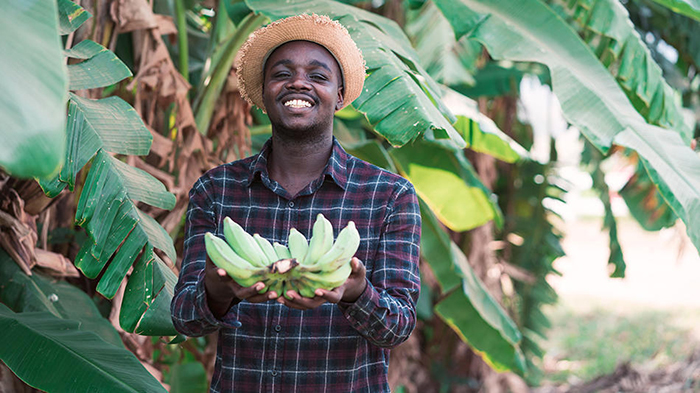
Figure 1 below shows the general supply chain of banana from the production area to the consumption area.
Figure 1 Banana's supply chain

(Created by Nittsu Research Institute and Consulting, Inc.)
Making an international comparison of banana imports and exports, there are the following six key findings.
Point 1. Banana productive capacity ≠ export capacity
Figures 2 and 3 show banana productivity and imports by country, respectively. Comparing these, countries that produce a lot of bananas do not necessarily export a lot of bananas. In particular, although India is ranked first and China is ranked second in banana production, their banana exports are not very high. China ranks 9th in export volume, which is low for a large banana producing country.
Why is the export volume so small even though they produce large amount? Since these two countries have very large populations, India with about 1.26 billion and China about 1.37 billion, the domestic consumption is also large; therefore the export volume is very small. Besides India and China, the same reasoning can be applied for other populous countries, like Brazil and Indonesia.
Point 2. "Transit point" the Netherlands and Belgium
Figure 3 shows the interesting banana exporters, that is the Netherlands and Belgium. Why do the Netherlands and Belgium rank high as banana exporters when they both are not located in tropical and subtropical areas? This is because they would be functioning as transit points for bananas in Europe due to their international ports.
Figure 2 Banana production by country (2018), Unit: tons
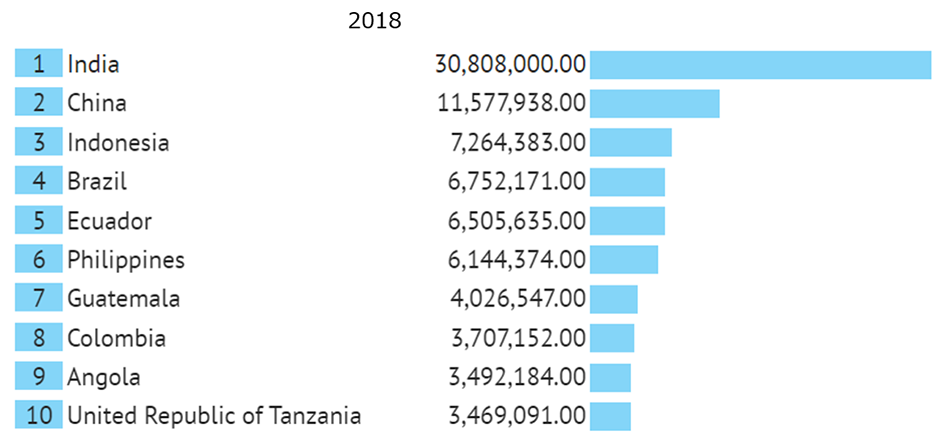
Source) https://knoema.com/
Figure 3 Banana exports by country (2019), Unit: million US dollars
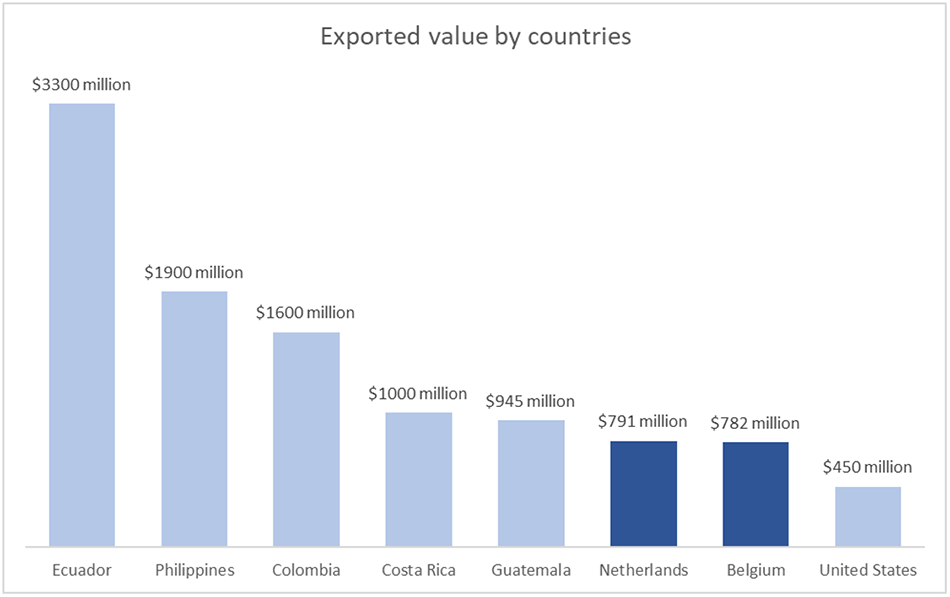
Source) http://www.worldstopexports.com/bananas-exports-country/
Point 3. The import value of bananas of the US is by far the largest and Japan comes sixth in the world
In 2019, the import value of the United States is the highest, which is about 2.5 times the import value of Russia's banana, which is the second largest, making the United States the world's largest importer of bananas in value. On the other hand, Japan's banana imports are the sixth largest in the world, but it can be said that banana consumption is high for the Japanese population. The data also show that most of the world's major banana importers are from North America, Europe and East Asia.
Figure 4 Banana imports by country (2019), Unit: million US dollars
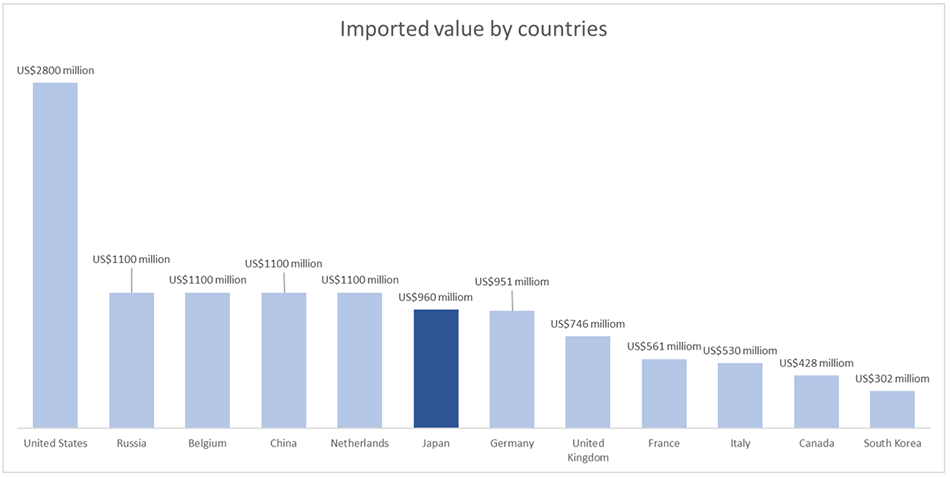
Source) http://www.worldstopexports.com
Point 4. The Philippines is Japan's biggest import partner
As shown in Figure 5, the bananas imported by Japan are mostly from the Philippines. It is said that the COVID-19 shock has reduced the supply of bananas from the Philippines, and the share of banana imports from Ecuador has slightly increased.
Figure 5 Japan Banana imports by country (2018), Unit: million US dollars
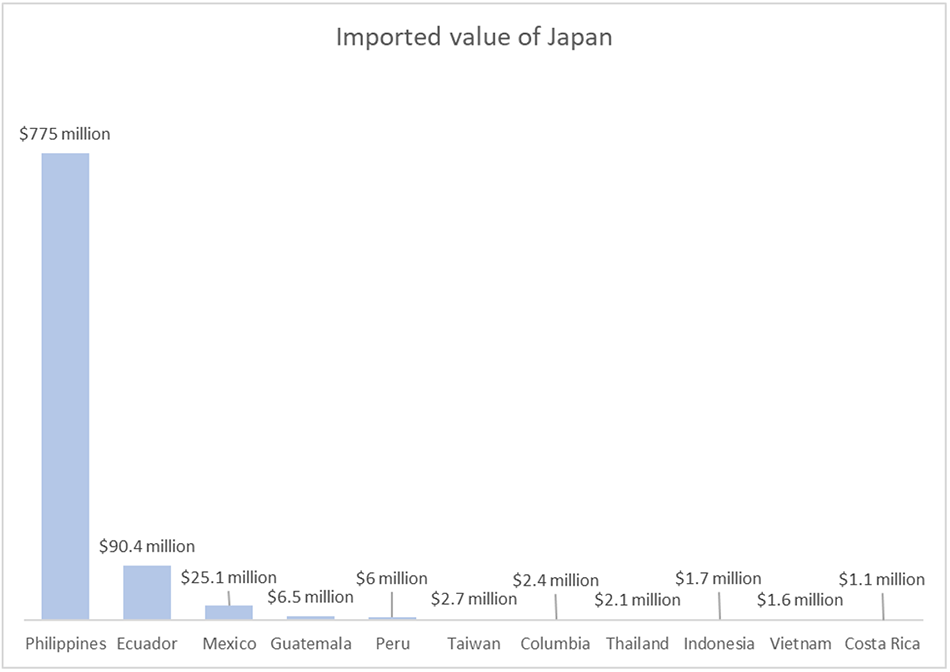
Source) http://www.e-stat.go.jp/stat-search
Point 5. The banana import partner of the US is Latin America
As shown in Figure 6, the banana import partners of the United States are very different from Japan and China, which are major banana importers in Asia, and the United States mainly imports from Central and South America. The amount of imports from Guatemala is by far the largest.
Figure 6 The US Banana imports by country (2019), Unit: million US dollars
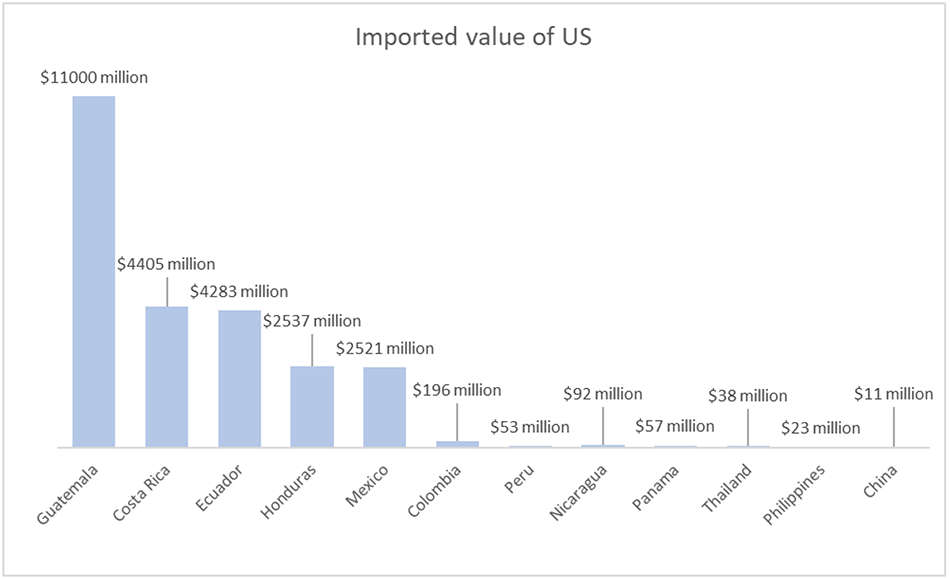
Source) http://www.worldstopexports.com
Point 6. China's largest banana import partner is also the Philippines
Figure 7 shows China's banana import partners. Like Japan, the Philippines is the largest partner, but Ecuadorian and Vietnamese bananas also have a large share.
Figure 7 China Banana imports by country (2019), Unit: million US dollars
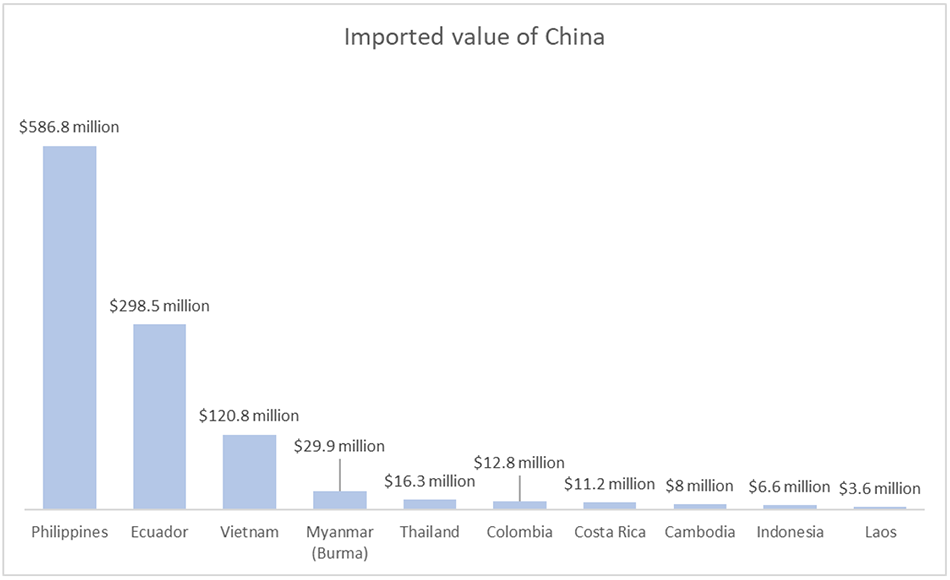
Source) http://www.worldstopexports.com
Bananas have become a staple in many family tables around the world today with the help of the development in logistics technologies. Since bananas are popular for their reasonable price, being nutritious, and are hassle-free kind of fruit, there is a view that the demand for bananas is rising slightly despite the shortage of supply.
Since this March, due to the spread of the COVID-19 infection, many schools have been temporarily closed and also many workers started working from home. Therefore, more people than ever are spending their time at home during the day. The supply-demand balance of bananas may be affected accordingly if such situation lasts longer. We should pay attention to how the banana supply chain would be changed in the post-COVID-19 era.